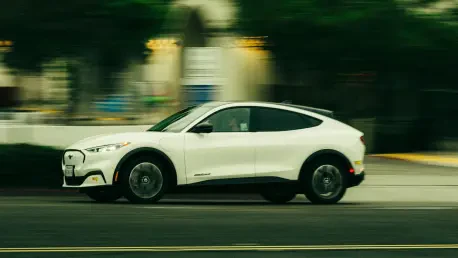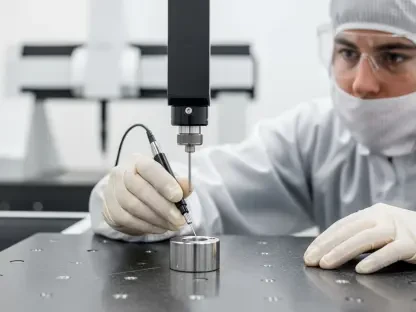In a rapidly evolving European automotive market where electric vehicles (EVs) are becoming the go-to choice for eco-conscious urban dwellers, Nio, a Chinese manufacturer, has introduced its latest offering, the Firefly, marking a significant milestone with its debut in Germany. Delivered to eShare One, a Dortmund-based company focused on e-mobility and car-sharing solutions, this small EV represents Nio’s first production model to hit German roads, signaling the brand’s ambitious push into a competitive segment. As small electric cars gain popularity for their practicality and lower environmental impact, the Firefly emerges as a fresh contender aiming to challenge established players with a blend of innovative design and functionality. This comprehensive evaluation dives deep into a hands-on test of the vehicle, exploring its performance, features, and overall potential to capture the attention of European consumers. From its compact yet spacious layout to its driving dynamics and market positioning, the test sheds light on whether this newcomer can stand toe-to-toe with giants like VW and Hyundai. The insights gathered offer a window into Nio’s strategy to carve out a niche in a crowded field, highlighting both the strengths that could win over buyers and the hurdles that lie ahead in gaining widespread acceptance.
Unveiling a Compact Powerhouse
The Firefly’s arrival in Germany sparks curiosity about how a Chinese automaker can disrupt the small EV landscape dominated by European and Korean brands. Measuring just four meters in length and 1.78 meters in width, this vehicle challenges preconceived notions of what a small car can offer by delivering interior space that rivals compact models like the VW Golf. Its well-proportioned exterior and wider stance project a sturdy, confident presence on the road, avoiding the fragile look often associated with cars in this category. Beyond mere aesthetics, the emphasis on space efficiency stands out as a key selling point, catering to urban drivers who need a vehicle that fits tight city streets while still accommodating their daily needs. The thoughtful design ensures that despite its modest footprint, the Firefly feels anything but cramped, setting a high bar for competitors in terms of balancing size with usability.
Practicality takes center stage with storage solutions that enhance the Firefly’s appeal for everyday use. A 404-liter trunk provides ample room for groceries or weekend gear, while a 92-liter frunk (front trunk) adds extra capacity for smaller items, a feature not always found in small EVs. Hidden storage compartments further maximize space, though some lack the quick accessibility needed for frequently used belongings, presenting a slight drawback. Nevertheless, this focus on creating a roomy environment within tight dimensions positions the Firefly as a versatile option for those navigating bustling urban environments. The clever use of space not only addresses practical concerns but also hints at Nio’s intent to redefine expectations in a segment often criticized for sacrificing comfort for compactness.
Powering Through with Efficiency
Under the hood—or rather, beneath the floor—the Firefly is equipped with a 105 kW electric motor on the rear axle, capable of peaking at 119 kW, paired with a 42.1 kWh LFP battery. This setup delivers a WLTP range of up to 330 kilometers, a figure validated by real-world testing that achieved around 350 kilometers under mixed urban and suburban conditions. Such a range makes the vehicle an ideal companion for daily commutes, errands, and even short out-of-town trips, reducing the anxiety often associated with EV travel. Efficiency remains a strong suit, with consumption rates staying impressively low, ensuring that drivers can maximize distance without frequent stops. This performance underscores Nio’s commitment to creating a small EV that doesn’t just meet basic needs but exceeds them in terms of reliability for typical usage patterns.
Beyond raw numbers, the Firefly’s energy efficiency translates into tangible benefits for cost-conscious consumers. Real-world data indicates consumption as low as 11-12 kWh per 100 kilometers in city driving, climbing to 16-17 kWh at higher speeds like 130 kph on highways. This balance of power and frugality means owners can expect a practical range that holds up under varied conditions, whether weaving through traffic or cruising on open roads. The ability to stretch each charge further positions the vehicle as a smart choice for those looking to minimize operating costs while maintaining a green footprint. As small EVs become more mainstream, this level of efficiency could be a deciding factor for buyers weighing options in a competitive market.
Charging Ahead with Practical Solutions
While the Firefly doesn’t feature Nio’s innovative battery-swap technology in Europe due to the absence of compatible infrastructure, it compensates with solid conventional charging capabilities. Supporting a peak power of 91 kW, the vehicle can recharge from 10% to 80% in approximately 30 minutes, aligning with industry standards and matching rivals in its class. This quick turnaround is crucial for urban drivers who rely on fast top-ups during busy schedules, ensuring minimal downtime. However, the charging curve tends to taper off after reaching 50%, which could extend wait times for a full charge. Despite this, the overall performance in replenishing energy remains competitive, offering a viable solution for those without access to home charging setups.
A closer look at the charging experience reveals room for software refinement. The Firefly’s route planning system, designed to suggest charging stops during longer journeys, often schedules unnecessarily extended pauses, which can disrupt travel flow. While the interface is user-friendly compared to some competitors, drivers may need to manually adjust plans for shorter, more frequent stops to optimize efficiency. This minor hiccup highlights an area where updates could enhance usability, ensuring the system better aligns with real-world needs. As charging infrastructure continues to expand across Europe, addressing such software quirks will be key to maintaining driver satisfaction and keeping pace with evolving expectations in the EV space.
Mastering the Road with Agility
On the road, the Firefly surprises with a driving experience that feels more akin to a compact car than a typical small EV. Its well-tuned chassis strikes an impressive balance between comfort and stability, adeptly handling both tight city corners and smoother highway stretches. The rear-wheel-drive configuration enhances maneuverability, boasting a tight turning radius that makes navigating urban environments a breeze. Even at speeds up to 130 kph, the vehicle maintains straight-line composure, avoiding the jittery feel often found in smaller models. This refined dynamic capability suggests that Nio has prioritized driver engagement, delivering a ride that inspires confidence across varied terrains.
Comfort remains a consistent theme during extended drives, with the suspension setup avoiding excessive softness in corners while still absorbing bumps effectively. This balance ensures passengers aren’t jostled during city commutes, nor do drivers feel overly fatigued on longer journeys. The Firefly’s ability to blend agility with stability sets it apart in a segment where handling can often be an afterthought. For urban dwellers who occasionally venture beyond city limits, this versatility offers a compelling reason to consider Nio’s offering over more established names. The focus on creating a polished driving experience could resonate strongly with buyers seeking a small EV that doesn’t compromise on road presence or ride quality.
Crafting a Premium Interior Ambiance
Stepping inside the Firefly reveals a minimalist interior design that draws inspiration from Nio’s larger, more upscale models, creating an environment that feels unexpectedly premium for its class. A large central touchscreen dominates the dashboard, complemented by a small instrument display and high-quality materials like soft, foamed plastics and fabric coverings. Adjustable ambient lighting adds a sophisticated touch, elevating the cabin’s atmosphere beyond what’s typically expected in a small EV. This attention to detail in crafting a refined space signals Nio’s intent to target buyers who value aesthetics and comfort as much as functionality, setting a benchmark for interior quality in this price range.
However, the minimalist approach comes with trade-offs in practicality that might irk some users. While the overall design exudes elegance, accessible storage for everyday items is limited, with many compartments tucked away in less convenient spots. This can make stashing frequently used belongings a bit of a hassle during daily routines. Although the premium feel and upscale elements are undeniable strengths, the lack of intuitive storage solutions could detract from the overall user experience for those prioritizing ease of use over style. Balancing these design choices with more practical layouts in future iterations could help address this minor but noticeable shortcoming, ensuring the interior appeals to a broader audience.
Navigating Technology and Assistance Features
The Firefly comes equipped with Nio’s suite of driver assistance systems, though these are built on software dating back to 2023, which feels somewhat outdated compared to newer implementations in other Nio models. Alerts for speed deviations and driver attention are often overly sensitive, leading to frequent and sometimes unnecessary notifications that can become distracting. While the intent behind these safety features is commendable, their conservative thresholds may frustrate drivers who prefer less intrusive technology. Updating the software to align with more recent standards seen in other Nio vehicles could significantly improve the user experience, reducing annoyance and enhancing trust in the system’s reliability.
On a more positive note, the route planning software for charging stops stands out for its intuitive design, offering clear guidance during long drives. However, it occasionally suggests overly extended breaks that don’t always match practical needs, requiring manual adjustments for optimal efficiency. Compared to some competitors, this feature still feels more user-friendly, providing a solid foundation that could be fine-tuned with minor updates. As technology continues to play a pivotal role in EV adoption, ensuring that assistance systems and planning tools are both accurate and unobtrusive will be crucial for Nio to maintain a competitive edge. Refining these elements could turn a functional aspect into a standout selling point for tech-savvy buyers.
Positioning in a Crowded Market
In terms of pricing, the Firefly enters the market at €29,900 in the Netherlands, with potential variations in Germany, placing it above some budget-friendly small EVs like the Hyundai Inster. Rather than competing on cost alone, Nio appears to target consumers who prioritize design, quality, and driving experience over rock-bottom prices, aligning more closely with premium brands like Mini. This strategy positions the vehicle as a value-driven choice for those willing to invest in a polished product, but it also means facing scrutiny over whether the price justifies the features on offer. Establishing a clear value proposition will be essential for Nio to attract discerning buyers in a segment with diverse expectations.
The challenge of market positioning extends beyond pricing to how the Firefly differentiates itself from rivals. While it excels in space efficiency and interior quality, it lacks the iconic brand heritage that competitors like Mini leverage to command premium pricing. Nio must find ways to build trust and recognition among European consumers unfamiliar with the brand, potentially through targeted marketing or partnerships that highlight the vehicle’s unique strengths. Offering attractive financing options or subscription models could also lower the entry barrier, making the Firefly a more accessible choice. Success in this competitive arena will hinge on striking the right balance between perceived value and tangible benefits for potential buyers.
Overcoming Brand Recognition Barriers
Entering a market dominated by well-known names presents a significant hurdle for Nio, as brand familiarity often influences purchasing decisions in the automotive sector. Unlike established players with decades of consumer trust, the Chinese manufacturer must work harder to prove the Firefly’s worth, particularly at a price point that isn’t the lowest in its class. Building credibility could involve showcasing the vehicle’s superior design and efficiency through real-world testimonials or partnerships with trusted local entities. Without a storied legacy to fall back on, Nio’s ability to create a compelling narrative around its small EV will play a critical role in swaying skeptical buyers.
Another avenue for overcoming recognition challenges lies in innovative ownership models that reduce risk for first-time buyers. Leasing programs or subscription services could allow consumers to experience the Firefly without a long-term commitment, potentially converting skeptics into advocates. Additionally, emphasizing post-purchase support, such as robust warranties or accessible service networks, might reassure buyers about investing in a lesser-known brand. As Nio navigates these waters, strategic moves to build a foothold—whether through competitive adjustments or enhanced customer engagement—will determine whether the Firefly can emerge as a household name in Europe’s small EV market over the coming years.
Striking a Balance for Future Success
Reflecting on the comprehensive test conducted in Germany, the Firefly proved itself as a noteworthy entrant with strengths that caught attention across multiple dimensions. Its spacious design, efficient range, and engaging driving dynamics demonstrated Nio’s capability to craft a small EV that exceeded typical expectations, offering a glimpse of what a newcomer can bring to a saturated field. The premium interior and solid charging performance further solidified its appeal, even as minor software and usability issues surfaced as areas needing attention. The evaluation painted a picture of a vehicle with immense potential, held back only by fine-tuning requirements and the broader challenge of market acceptance.
Looking ahead, Nio faces the task of refining these rough edges to ensure the Firefly remains competitive. Addressing software sensitivities in driver assistance systems and optimizing route planning for charging stops emerge as immediate priorities to enhance user satisfaction. Meanwhile, tackling the brand recognition barrier through strategic pricing adjustments or innovative ownership models stands out as a pathway to broader adoption. By focusing on these actionable steps, Nio positions itself to elevate the Firefly from a promising debut to a staple choice for European urban drivers, paving the way for deeper inroads into a market hungry for fresh, reliable electric options.









